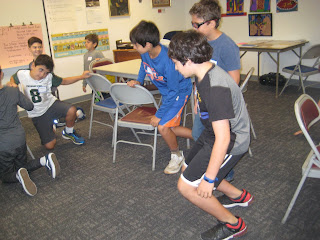Yesterday, I continued our discussion by asking the students, "If we couldn't live together, how is it that we always remembered who we were and where we came from, and kept our national identity? How did we preserve it and, even more importantly, WHY did we do so? To help begin to discover the tie(s) that have bound us together through space and time, and continue to do so, I introduced a quotation from Rabbi Moses Ben Maimon, who lived about 1,000 years ago (also known as RAMBAM and Maimonides).
“Awake, awake, you slumberers from your sleep, inspect your actions and return.”
We discussed what Rambam meant in this statement, realizing that he was speaking metaphorically. I then asked the class to listen very carefully to the sounds of the shofar on this link (I played minutes 1:56 to 3:18). When we had finished listening, I hung up two posters on our whiteboard, describing the shoresh (root letters) for each of the following words: shofar, t'ru'ah, sh'vareem and t'kee'ah.
Very briefly, the word shofar is built from the 3-letter shoresh "shin-fey-resh." All words built from these 3 letters must have something to do with "improvement." The shofar is an instrument of improvement. All words built from the 3-letter shoresh "tav-resh-ayin" must have something to do with "alarm." The 9 staccato sounds which we blow on the shofar are named t'ru'ah - a sound of alarm. All words built from the 3-letter shoresh "shin-vet-resh" must have something to do with "broken." The 3-beat sounds we blow on the shofar are named sh'vareem. Finally, all words built from the 3-letter shoresh "tav-koof-ayin" must have something to do with "repair." Thus, the shofar, the instrument of improvement, is speaking to us - "Alarm! Something is broken and must be repaired."
We discussed how the sounds of the shofar related to RAMBAM's quotation and agreed that we listen to the shofar on Rosh Ha'shana (Jewish new year) and Yom Kippur (Day of Atonement) because we want to "be awakened" by the sound of the shofar (our Jewish alarm clock, if you will) to look around ourselves and in ourselves and "repair" and strengthen our relationships with the people around us, with our community, and with God and God's Universe.
I shared that it's not just on Rosh Ha'shana and Yom Kippur that we are commanded to listen to the shofar, but during the entire previous month (Elul) as well. Every day of Elul, except for Shabbat, we are all asked to "look back at our deeds" from the previous year and "take stock" of how we've treated ourselves, our fellow human beings, God and God's Universe. We're asked by the Rabbis to form a plan for improving these relationships over the coming year.
I finished this part of the lesson by having the students listen to the sound of t'kee'ah g'dola (literally, "big tekiah") (minutes 3:19-4:39 of the above link), which is the final sound we hear blown on Rosh Ha'shana and Yom Kippur (it's blown in this link for an impressive 40 seconds!!!).
Next Sunday, we'll continue to explore WHY our Jewish nation has maintained its national identity in both good times and bad, and tie what we learn to yesterday's lesson. Stay tuned!
We used the remaining quarter of an hour of our session yesterday for our first Hebrew Through Movement lesson of the year. So many students - both 5th and 6th graders - recalled a good deal of the vocabulary I reviewed with them!
 |
| Baneem, la'shevet al ha'shoolchan. (Boys, sit on the table.) |
 |
| Baneem, la'shevet al ha'beerka'eem, al ha'reetzpa. (Boys, sit on the knees on the floor.) |
 |
| Baneem, la'seem yada'eem al ha'reetzpa. (Boys, put hands on the floor.) |
 | ||
| Achshav, baneem, la'lechet al ha'beerka'eem v'al ha'yada'eem al ha'reetzpa. (Now, boys, walk on the knees and on the hands on the floor. |
After spending almost 15 minutes walking, running, jumping, turning around, getting down on the floor and up on the tables, I decided to finish the session with some deep breathing - "leenshom pa'am achat" ("breathe once"), "leenshom sh'nei p'ameem" ("breathe twice"), "leenshom shalosh p'ameem" ("breathe three times"). Then all the students followed the command, "La'koom v'la'seem ha'keeseh mee'tachat la'shoolchan. Achshav, la'lechet l'beit ha'meekdash b'yachad." ("Get up and put the chair under the table. Now, walk to the Sanctuary together.") It was time for our tefillah service.
Let me take this opportunity to wish you all a very happy and healthy 5778.
L'SHANA TOVA TEEKATEIVOO! (MAY YOU BE WRITTEN FOR A GOOD YEAR!)
No comments:
Post a Comment